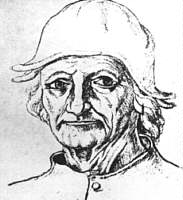
|
Special thanks to the Microsoft Corporation for permission to use following biographical information from Microsoft® Encarta '97:
The documents about Bosch indicate that he followed the predictable life of a prominent Roman Catholic artist in 's Hertogenbosch, a provincial but prosperous town located in the modern Netherlands close to the Belgian border. His father and grandfather were both painters in the same town before him, and apparently Bosch lived all his life there. He married a local woman and joined the lay organization of the Confraternity of Notre Dame. Bosch was responsible for designing a stained-glass window, among several other works, for the town church. His art was well known outside 's Hertogenbosch during his lifetime.
References to astrology, folklore, witchcraft, and alchemy, in addition to the theme of the Antichrist and episodes from the lives of exemplary saints, are all woven together by Bosch into a labyrinth of late medieval Christian iconography. Scholars differ in their interpretation of Bosch's art, but most agree that his pictures show a preoccupation with the human propensity for sin in defiance of God, as well as with God's eternal damnation of lost souls in hell as a fateful consequence of human folly.
Stylistically, Bosch worked in a manner called alla prima, a method of applying paint freely on a preliminary ground of brownish paint. He was familiar with Dutch manuscript paintings and with foreign prints, and many of his images can be traced to these sources.
Dated works by Bosch do not exist and, of those panels that bear his signature, many might have been by followers. His pictures were widely imitated well into the later 16th century. During the 1550s, a veritable Boschian revival occurred in Antwerp that involved artists such as Pieter Huys and even Pieter Bruegel the Elder, who openly made variations of his paintings. Descriptions of some of his works were written by 16th-century Spanish nobleman Don Felipe Guevara. Among other sources, these have aided modern art historians in determining Bosch's authentic works.
Among the dozens of Boschian paintings, the autograph works generally accepted as his include the following: The Marriage at Cana (Museum Boymans-van Beuningen, Rotterdam), The Seven Deadly Sins (Prado, Madrid), Crucifixion (Musées Royaux des Beaux-Arts, Brussels), The Hay Wain (Prado), The Death of the Miser (National Gallery of Art, Washington, D.C.), The Temptation of Saint Anthony (Museu Nacional de Arte Antiga, Lisbon), The Garden of Earthly Delights (Prado), The Adoration of the Magi (Prado), and Christ Carrying the Cross (Museum voor Schone Kunsten, Ghent).
|

